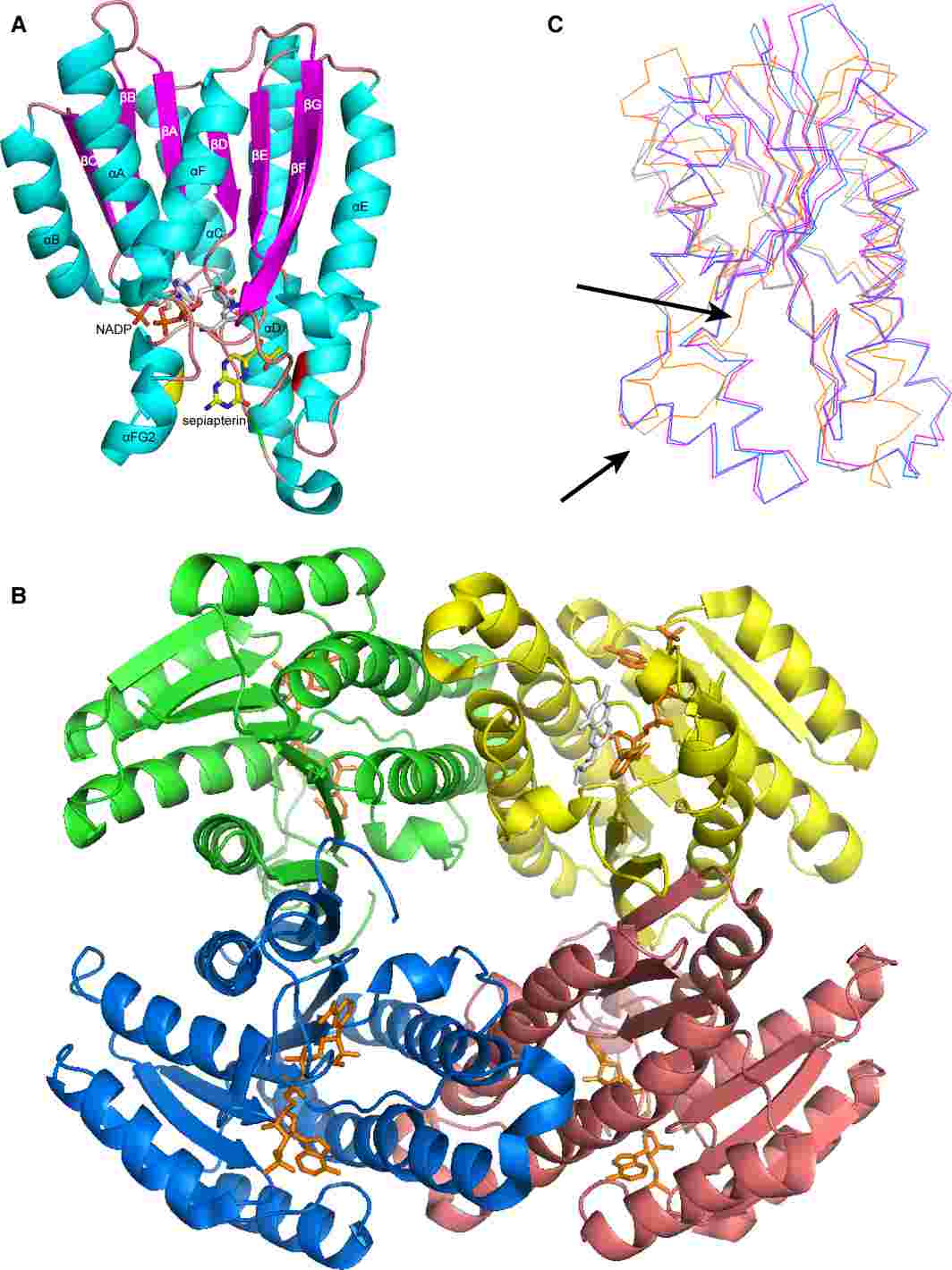What is SPR Protein
Sepiapterin reductase (SPR) protein, an intricate enzyme with far-reaching implications, plays a crucial role in diverse physiological processes.
What is SPR Protein?
At its core, SPR is an enzyme ubiquitous across diverse organisms, from bacteria to humans. Its fundamental role lies in the biosynthesis of tetrahydrobiopterin (BH4), a pivotal cofactor influencing neurotransmitter synthesis and nitric oxide production. Structurally, SPR catalyzes the conversion of sepiapterin to BH4, unraveling the intricacies of its functional significance.

Figure 1. The overall structure of CT-SPR. (Wu, Y., et al. 2020)
The Function of SPR Protein
- Neurotransmitter Synthesis
SPR's paramount contribution lies in neurotransmitter synthesis. Through its involvement in the conversion of sepiapterin to BH4, SPR facilitates the activity of enzymes like phenylalanine hydroxylase and tyrosine hydroxylase. These enzymes, dependent on BH4, govern the synthesis of neurotransmitters like serotonin and dopamine, regulating critical aspects of mood, behavior, and cognitive functions.
- Nitric Oxide Production
In addition to neurotransmitter synthesis, SPR actively participates in nitric oxide production. Nitric oxide, a signaling molecule, influences processes such as vasodilation, immune response, and neurotransmission. SPR's role in BH4 biosynthesis is integral to sustaining optimal nitric oxide levels, emphasizing its significance in cardiovascular health.
SPR-Related Diseases
- Phenylketonuria (PKU)
Dysfunction or deficiency of SPR manifests in diseases such as Phenylketonuria (PKU). SPR's role in the BH4 biosynthetic pathway connects it to phenylalanine hydroxylase, an enzyme crucial for phenylalanine metabolism. Insufficient BH4 due to SPR dysfunction results in the accumulation of phenylalanine, causing intellectual disabilities in PKU patients.
- Dopa-Responsive Dystonia (DRD)
DRD, a neurological disorder, underscores the impact of SPR on dopamine synthesis. Mutations affecting SPR function result in decreased BH4 levels, impairing the activity of tyrosine hydroxylase. This disruption in dopamine synthesis contributes to the development of DRD symptoms, highlighting the broader neurological implications of SPR dysfunction.
- Cardiovascular Diseases
SPR's role in nitric oxide production links it to cardiovascular health. Dysfunctional SPR may lead to impaired nitric oxide synthesis, contributing to conditions such as hypertension and endothelial dysfunction. Understanding these associations provides critical insights into potential therapeutic interventions targeting SPR for cardiovascular diseases.
SPR Related Signaling Pathways
- GTP Cyclohydrolase I (GCH1) Pathway
The biosynthesis of BH4 involves a complex cascade of enzymatic reactions, with GTP Cyclohydrolase I (GCH1) initiating the pathway. SPR operates downstream, converting sepiapterin to BH4. Disruptions in this pathway can have cascading effects on neurotransmitter synthesis and nitric oxide production, emphasizing the interconnectedness of SPR with crucial cellular processes.
- Dopaminergic Pathway
In the context of dopamine synthesis, SPR plays a pivotal role in converting sepiapterin to BH4. This process is vital for the subsequent conversion of tyrosine to dopamine by tyrosine hydroxylase. Dysregulation of this pathway, often associated with SPR dysfunction, provides a mechanistic understanding of conditions like DRD, offering potential targets for therapeutic interventions.
Applications of SPR in Biomedical Research
- Neurological Disorders
The unique role of SPR in neurotransmitter synthesis positions it as a potential therapeutic target for neurological disorders. Strategies aiming at modulating SPR activity or supplementing BH4 hold promise in managing conditions like Parkinson's disease and mood disorders. This avenue of research opens new doors for innovative neurological treatments.
- Cardiovascular Health
Manipulating SPR activity to enhance nitric oxide production emerges as a promising strategy for cardiovascular therapies. Targeting SPR could provide avenues for managing conditions associated with endothelial dysfunction and hypertension, offering potential breakthroughs in cardiovascular medicine.
- Drug Development
The comprehensive understanding of SPR-related signal pathways offers valuable insights for drug development. Small molecules designed to modulate SPR activity could become key players in developing targeted therapies for diseases linked to BH4 deficiency. The intricate knowledge of SPR's role in cellular processes paves the way for designing precise and effective pharmaceutical interventions.
In the intricate landscape of molecular biology, SPR protein stands as a linchpin in regulating critical physiological processes. From neurotransmitter synthesis to cardiovascular health, its far-reaching implications make it a focal point for scientific inquiry and biomedical innovation. As research progresses, the unraveling of SPR's complexities holds the promise of groundbreaking advancements, shaping the future of medical science and therapeutic interventions.
Recommended Products for SPR Protein
| Cat.# | Species | Product name | Source (Host) | Tag |
|---|---|---|---|---|
| SPR-2931H | Human | Recombinant Human SPR, GST-tagged | E.coli | GST |
| SPR-190H | Human | Recombinant Human Sepiapterin Reductase, His-tagged | E.coli | His |
| SPR-30400TH | Human | Recombinant Human SPR, His-tagged | E.coli | His |
| SPR-5524H | Human | Recombinant Human SPR Protein, Myc/DDK-tagged, C13 and N15-labeled | HEK293T | Myc/DDK |
| SPR-2090H | Human | Recombinant Human SPR Protein, His (Fc)-Avi-tagged | HEK293 | His (Fc)-Avi |
| SPR-1089HFL | Human | Recombinant Full Length Human SPR Protein, C-Flag-tagged | Mammalian cells | Flag |
| SPR-0243H | Human | Recombinant Human SPR Protein (M1-K261), Tag Free | E.coli | No tag |
| SPR-681H | Human | Recombinant Human SPR Protein, His/GST-tagged | E.coli | His/GST |
| Spr-682M | Mouse | Recombinant Mouse Spr Protein, His-tagged | E.coli | His |
| SPR-4446R | Rhesus Macaque | Recombinant Rhesus monkey SPR Protein, His-tagged | Mammalian Cell | His |
Reference
- Wu, Y., et al. Sepiapterin reductase: Characteristics and role in diseases. J Cell Mol Med. 2020, 24(17): 9495-9506.

